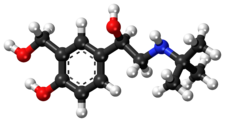 | |
 | |
| Clinical data | |
|---|---|
| Trade names | Xopenex, other |
| Other names | evalbuterol |
| AHFS/Drugs.com | International Drug Names |
| License data |
|
| Pregnancy category |
|
| Routes of administration | By mouth (tablets), inhalational (MDI) |
| Legal status | |
| Legal status | |
| Pharmacokinetic data | |
| Metabolism | Hepatic |
| Elimination half-life | 3.3–4 hours |
| Excretion | Urinary |
| Identifiers | |
| |
| CAS Number | |
| PubChem CID | |
| DrugBank | |
| ChemSpider | |
| UNII | |
| KEGG | |
| ChEBI | |
| ChEMBL | |
| CompTox Dashboard (EPA) | |
| ECHA InfoCard | 100.113.688 |
| Chemical and physical data | |
| Formula | C13H21NO3 |
| Molar mass | 239.315 g·mol−1 |
| 3D model (JSmol) | |
| |
| |
| | |
Levosalbutamol, also known as levalbuterol, is a short-acting β2 adrenergic receptor agonist used in the treatment of asthma and chronic obstructive pulmonary disease (COPD). Evidence is inconclusive regarding the efficacy of levosalbutamol versus salbutamol or salbutamol-levosalbutamol combinations, though levosalbutamol is believed to have a better safety profile due to its more selective binding to β2 receptors (primarily in the lungs) versus β1 (primarily in heart muscle).[2][3]
The drug is the (R)-(−)-enantiomer of its prototype drug salbutamol. It is available in some countries in generic formulations from pharmaceutical companies including Cipla, Teva, and Dey, among others.
- ^ "FDA-sourced list of all drugs with black box warnings (Use Download Full Results and View Query links.)". nctr-crs.fda.gov. FDA. Retrieved 22 Oct 2023.
- ^ Jat KR, Khairwa A (April 2013). "Levalbuterol versus albuterol for acute asthma: a systematic review and meta-analysis". Pulmonary Pharmacology & Therapeutics. 26 (2): 239–248. doi:10.1016/j.pupt.2012.11.003. PMID 23207739.
- ^ Punj A, Prakash A, Bhasin A (November 2009). "Levosalbutamol vs racemic salbutamol in the treatment of acute exacerbation of asthma". Indian Journal of Pediatrics. 76 (11): 1131–1135. doi:10.1007/s12098-009-0245-4. PMID 20012785. S2CID 11566782.